
Date: 2025-07-10 Page is: DBtxt003.php txt00024410
GUN VIOLENCE
WASHINGTON POST SERIES (MARCH 2023)
The policing paradox
As cops patrol America’s gun-saturated streets, the AR-15
can be a deadly threat — or a source of protection
WASHINGTON POST SERIES (MARCH 2023)
The policing paradox
As cops patrol America’s gun-saturated streets, the AR-15
can be a deadly threat — or a source of protection
| HOME | BRIEFS | L020-IS-ISSUES-ALPHA | L020-IS-ISSUES-CHRONO | Last txt00024409 | Next txt00024411 |

A Colorado Springs police officer at the annual Medal of Valor ceremony in
September. The city police department has responded to several mass shootings
in recent years, and many officers now carry AR-15s.
Original article: https://www.washingtonpost.com/nation/interactive/2023/police-ar-15-gun-control/
Peter Burgess COMMENTARY
I have not experienced US gun violence directly, but I am fairly good at understanding data and paying attention to news about current events. And current events in the USA are more often than not dominated by some mass shooting somewhere in the country.
This Washington Post series documents some of the disturbing reality about gun violence and the aftermath. It may disappear from the 'news' very quickly but for those impacted the trauma lasts a long time if not for ever.
Peter Burgess
As cops patrol America’s gun-saturated streets, the AR-15 can be a deadly threat — or a source of protection
Story written by by Robert Klemko
Photography by Joshua Lott
Published on March 27 at 6:13 a.m.
COLORADO SPRINGS — Chris Burns tore the AR-15 out of his patrol cruiser, wrapping the rifle sling around his body, feeling he might be forced to shoot a man for the first time in more than two decades as a police officer.
He was training his weapon on a suspect who had leaped from a wrecked stolen car and appeared to be carrying a tactical rifle of his own. The man had stopped outside a car parked at a gas station fuel pump. Burns didn’t know if anyone was inside the vehicle.
For Burns, it was the nightmare scenario: Hefting the weapon of war he’d started carrying after the 1999 Columbine High School massacre, hoping for a fighting chance as he confronted a suspect, knowing the bullet-resistant vests he and his fellow officers were wearing would fail if the man sent a fusillade of high-speed bullets their way.
“We might as well have been naked,” he said, recalling that crisp day in April 2021.
Police departments that once deferred to SWAT teams wielding military-style rifles for active-shooter situations have in recent years started equipping the rank and file with AR-15s and other long guns, as those weapons have flooded neighborhoods and communities.
Many officers welcomed the change, some even buying their own AR-15s and using them for sport or hunting when not on duty. But police often say they still feel outgunned and ill-prepared — struggling to balance demands that they avoid using force against the knowledge that at any moment they could be called to stop a mass killing in progress.
Those potentially conflicting impulses reflect a policing paradox deepened by America’s obsession with the AR-15: The weapon can, depending on the circumstances, be an officer’s greatest threat or a potentially lifesaving tool.
“Police academies often aren’t well equipped to train with long guns,” said Pete Kraska, a professor of justice studies at Eastern Kentucky University who studies police militarization. Years ago, he argued that law enforcement agencies were adding tactical weapons unnecessarily. But with both mass killings and open-carry laws on the rise, he said, “It’s now a credible argument to say we have to engage in an arms race because we’re outgunned.”
The dilemma has emerged as a critical factor in last year’s mass killing at Robb Elementary School in Uvalde, Tex., according to a recent Texas Tribune investigation, which found police waited more than an hour before confronting the gunman because they feared they lacked the firepower to compete with him. And it looms large every day in Colorado, where open carry is generally legal, many law enforcement agencies have resisted taking guns from risky people, and the map is peppered with the names of towns and cities where mass killings have occurred.
An independent 2022 assessment of the Colorado Springs Police Department’s use of force, commissioned by the city, revealed that more than 8 in 10 officers surveyed said their training on the use of force and how to de-escalate was inadequate, and more than 9 in 10 officers said they needed more training on when to use their firearms.
The police department declined to comment on the survey results, and Police Chief Adrian Vasquez declined an interview request.
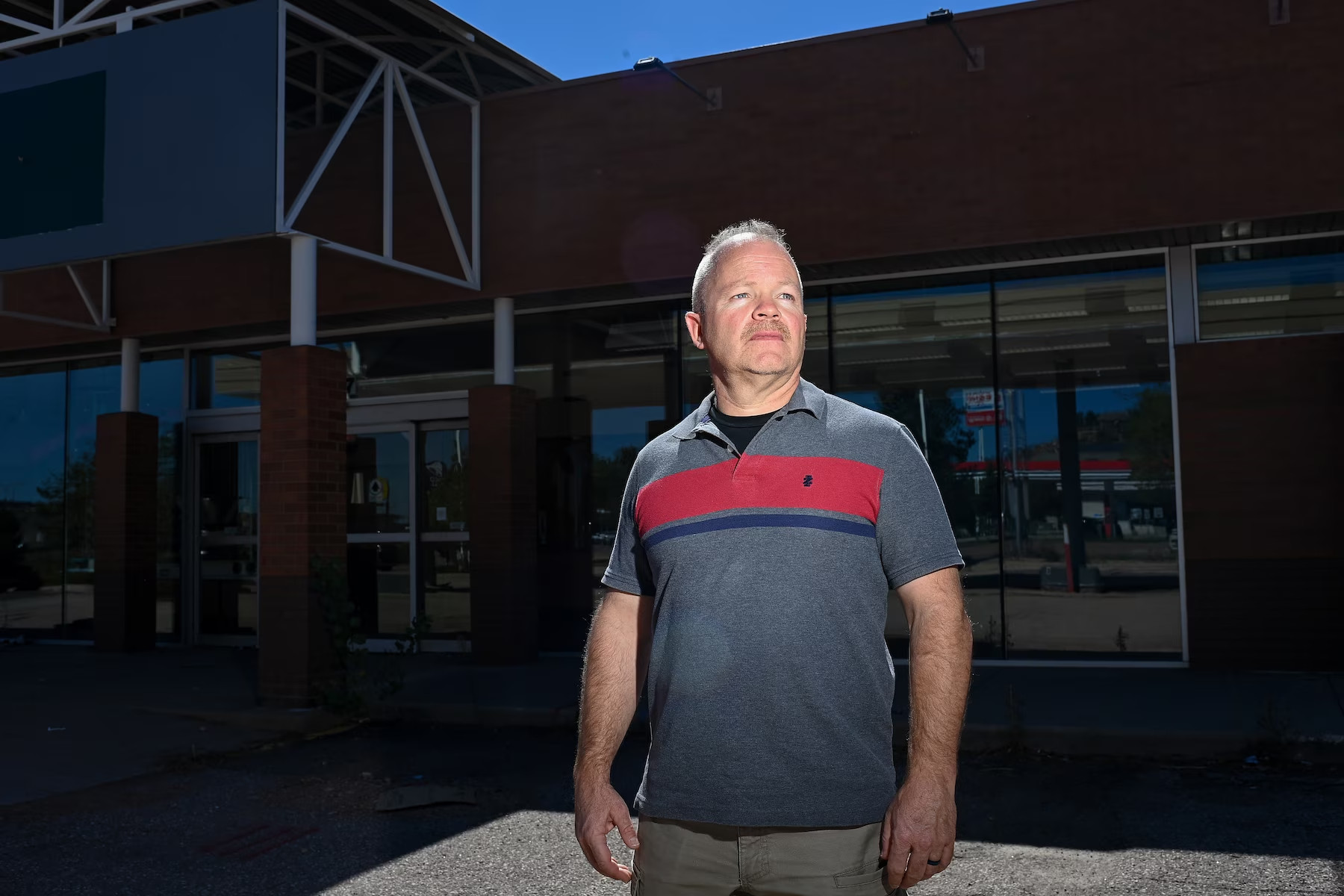
Retired Colorado Springs police officer Chris Burns.
“Almost everyone going through the academy has never been punched in the mouth,” Burns said in an interview. “They’re resorting to their Taser and their gun. … You end up with a lot of young, inexperienced police officers cutting their teeth in these really dangerous situations.”
Burns, a training officer, hostage negotiator and former Iraq War helicopter pilot, was no stranger to the risks of confronting heavily armed suspects by the time he arrived on the scene of that 2021 incident at the Colorado Springs gas station.
Six years earlier, he had responded to a shooting at a Colorado Springs Planned Parenthood, engaging in a five-hour standoff with the suspect before the SWAT team intervened and arrested him.
In the gas station incident, the suspect facing Burns was a 37-year-old man named Richard Quintana, who had been ordered more than 70 times to drop the weapon, a prosecutor would later say.
The muzzle of Quintana’s weapon was under his chin, and it was unclear whether people were inside the car he stood next to. As Burns pondered his options, it was also unclear how skilled Quintana was with a military-style weapon — and whether Burns’s own training had prepared him for this moment. The department requires 40 hours of training to carry the rifle and an annual qualifying exam.
“The average gun owner has trained more hours with their AR-15 than a cop has,” Burns said.
An arms race for police
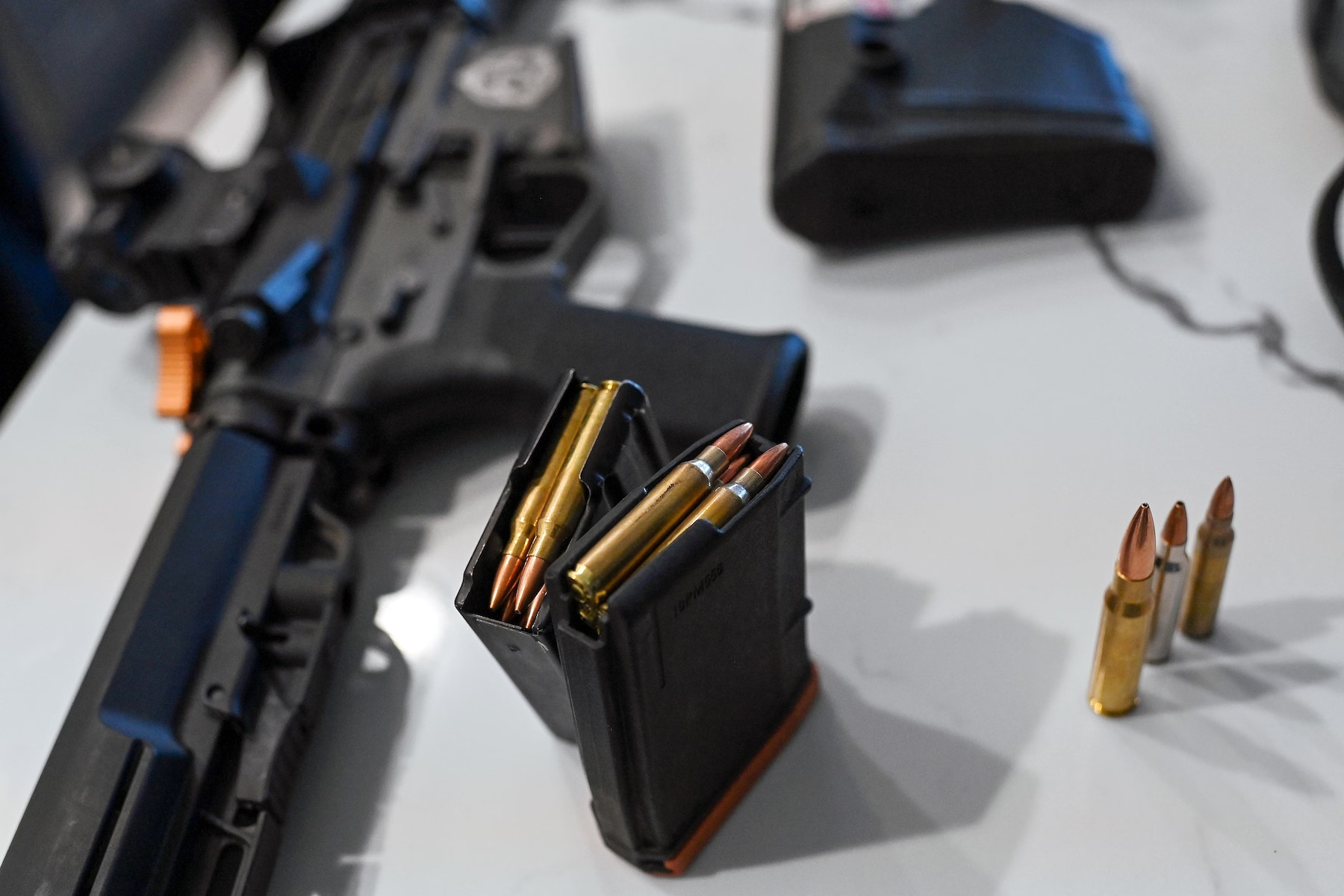
I.C.E. Training founder Rob Pincus's AR-15 and ammunition.
Police departments’ shift toward tactical weapons began in the wake of two American tragedies, a 1997 bank robbery in North Hollywood, Calif., where police officers equipped only with pistols and shotguns commandeered AR-15s and other weapons from a nearby gun store to match the robbers’ firepower, and the 1999 massacre at Columbine High School in Colorado, in which police waited more than 40 minutes to enter the school.
“That was the sounding alarm for the police community,” Kraska said of the North Hollywood shooting. “Police culture is extremely steeped in a fear of victimization, and this incident accelerates that. It ends up creating a militarized set of assumptions in thinking and gear in everyday policing. It’s a very slippery slope to go from policing a civilian population to policing the enemy.”
In department after department, pistols and rifles with more ammunition and velocity replaced six-shooters and shotguns. Patrol officers and detectives were trained to pursue and confront active shooters immediately, without waiting for backup. Agencies across the country began requiring officers to wear body armor and buying up military-grade weapons and equipment, especially after the terrorist attacks of Sept. 11, 2001.
“I don’t hear officers saying we don’t need these weapons. The street officer is saying, ‘I need a more efficient sling. I need a better optic,’” said Rob Pincus, a firearms trainer and former sheriff’s deputy based in Colorado. “If the bad guys have these guns, we need them too.”
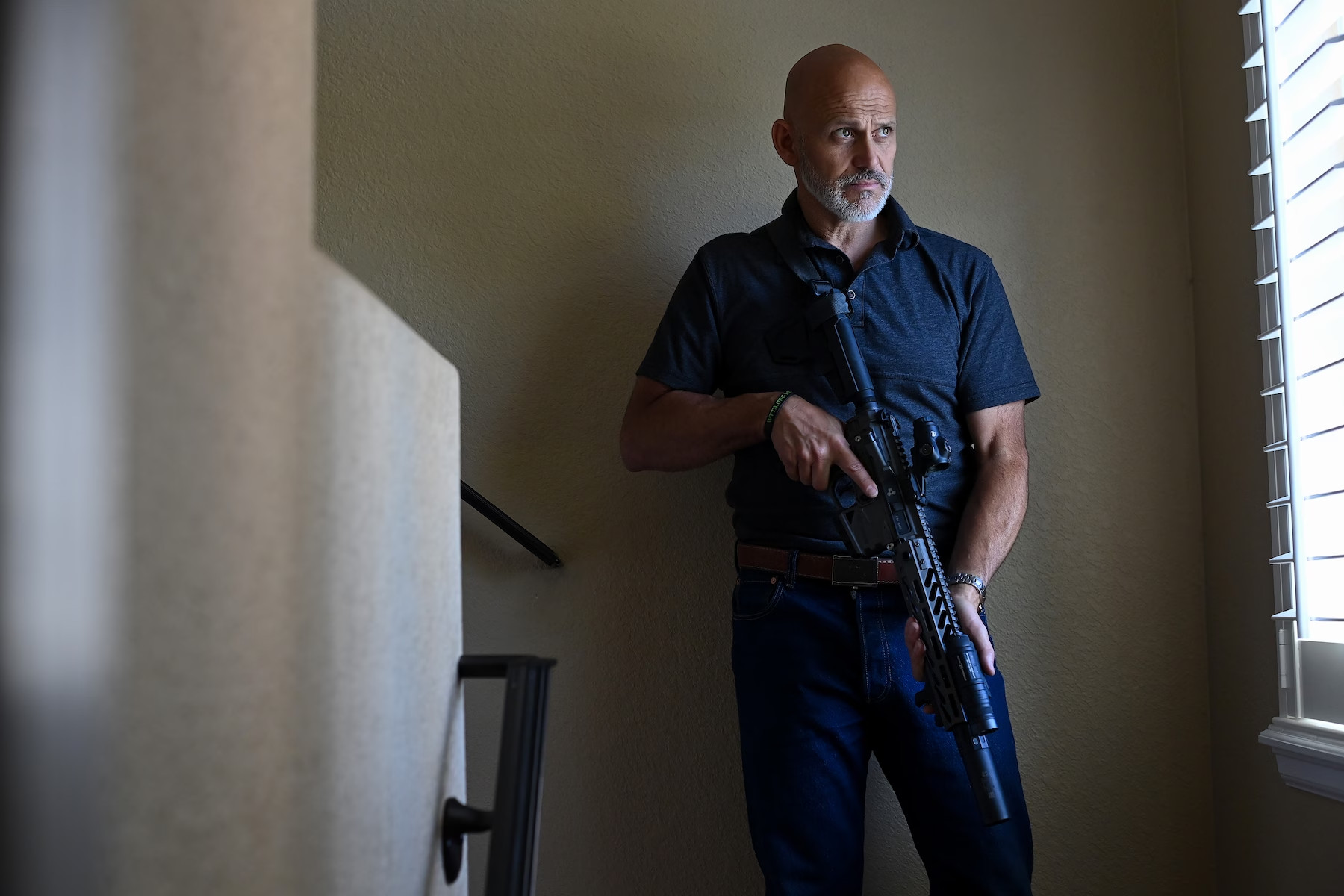
Pincus with an AR-15 at his home in Aurora, Colo.
Gary Darress, another longtime Colorado Springs police officer and friend of Burns, was issued a six-round Smith & Wesson Model 19 .357 revolver when he began his law enforcement career in 1985. The department later transitioned from revolvers to semiautomatic pistols, “because criminals got their hands on semi-autos,” Darress said.
That transition was manageable. The tactical rifle era, he says, was something else.
“It’s urban warfare,” Darress said. “Psychologically, when people have all this armament, that changes who you are and that changes your response to calls.”
Darress was issued his own AR-15 to carry in the car in 2008, but he didn’t tinker with it the way other officers do, customizing every aspect of the gun from the sling to the sight. Asked why, he said the gun was fine as it was. He leaned on what had already carried him through more than 20 years in policing — ever-evolving de-escalation techniques.
But the environment evolved too, with more and more residents openly and legally carrying pistols and rifles. In 2011, the Colorado Springs Police Department responded by telling dispatchers and patrol officers that simply seeing a person with a gun should not automatically prompt a police response. Instead, emergency operators were instructed to ask callers whether the armed person was acting erratically or unlawfully. If the answer was no, officers would probably stand down.
“Obviously, the problem is that when the open-carrying citizen is on their way to commit a crime,” Burns said dryly, “we have limited our ability to respond quickly.”
Colorado Springs saw the worst-case scenario unfold four years later, on Halloween 2015. A 911 caller told an emergency response technician that a man was walking downtown with a long gun and a gas can. Police assigned the call a low priority.
Soon, Noah Harpham began executing people with an AR-15 called the DPMS Classic 16.
Darress was a mile away, using the restroom. He sped to the scene, pulling up across the street from Harpham and a fast-food restaurant.
By that time, the gunman had killed three people.
Darress unholstered his pistol — he didn’t have time to grab his rifle, he said — and took cover behind his open driver’s side door, even though he knew it offered no practical defense against Harpham’s weapon.
But as Harpham began firing at him, Darress found he couldn’t pull the trigger.
“A voice tells me don’t shoot, because I’m facing a Wendy’s,” Darress said. “I pray to God that I’m a good shot. But one shot flies off to the left or right, and I’m going to shoot somebody in Wendy’s.”
Harpham fired eight times in the direction of Darress, who hit the ground and crawled behind his vehicle. Eventually, another Colorado Springs police officer, Randall Scott Hallas, flanked Harpham and shot him to death.
The mass shooting, followed by the Planned Parenthood attack a month later that killed one police officer and injured five other officers, contributed to an exodus from the city police department that year. The Colorado Springs Gazette reported that 52 officers left in 2015, with most departing after less than two years on the job and some citing the rising tide of violence in their resignation letters.
Many officers who stayed prepared for war, Darress and Burns said, with many buying their own rifles and customizing them to the scenarios they imagined they might encounter.
“When I started, I think human beings were much more able to do the job of law enforcement,” Darress said. “I don’t think people are designed for the intensity of law enforcement today.”
Policing’s political divide
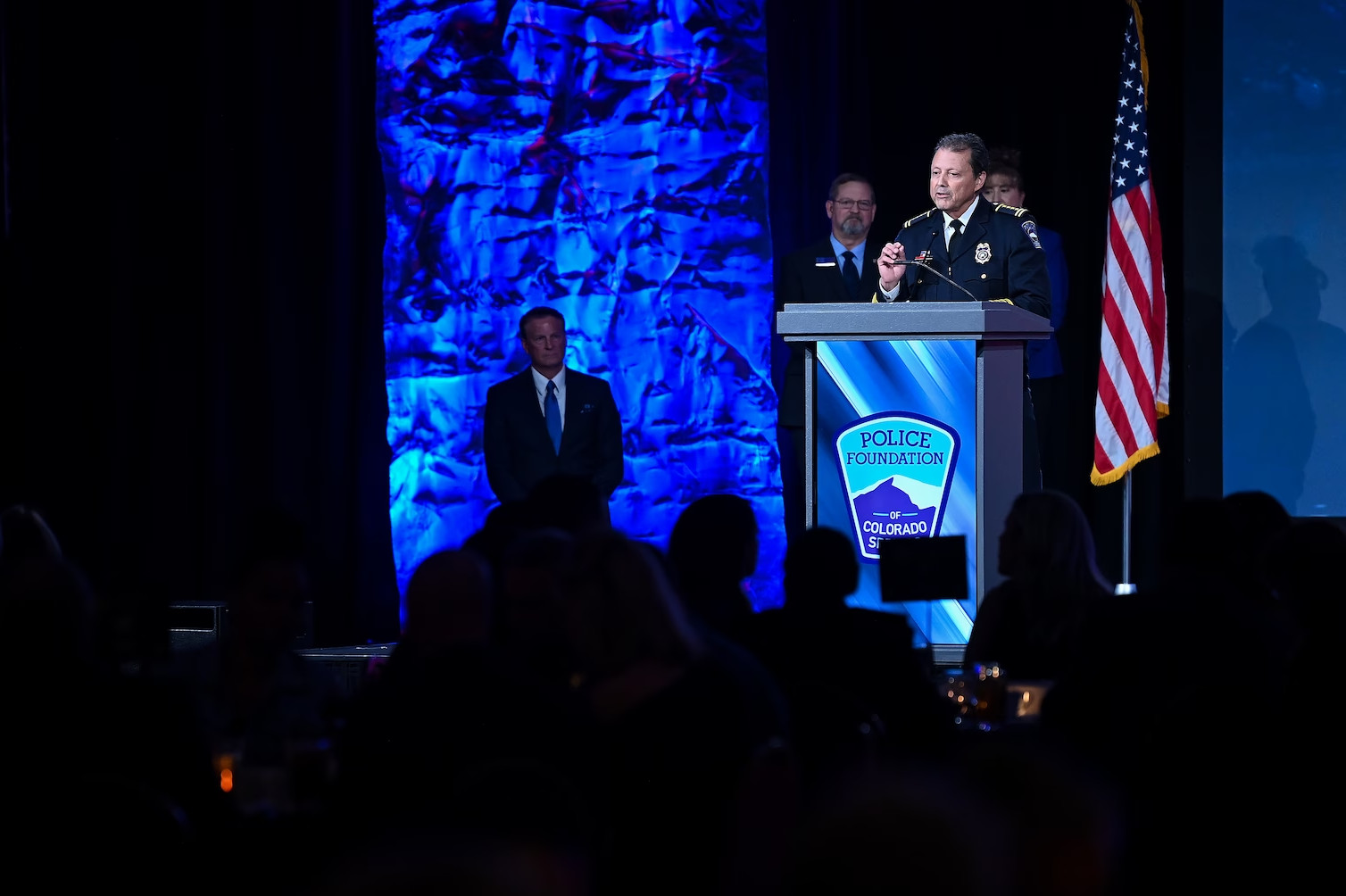
Colorado Springs Police Chief Adrian Vasquez at the Medal of Valor ceremony in September. It honored officers for their handling of critical incidents in 2021.
The Colorado Springs department issued Burns his first AR-15 in the mid-2000s, without any modifications, he said. Then he responded to a call of shots fired in the dead of night and realized he needed a flashlight mounted to the gun rail.
He bought his own AR-15 in 2008, equipping it with the rail light, a non-magnified red dot sight, and a handle with a tripod for mounting the gun on surfaces, such as the hood of a car. The whole package cost about $1,200, he said.
Burns kept the weapon in his car, between the driver’s seat and the passenger seat. Until two years ago, he had responded to several calls with it but never fired it while on patrol.
By 2021, on-the-job frustrations were mounting, he said. Among them: Too many men carrying guns illegally had entered the back of Burns’s patrol car in handcuffs and walked out of El Paso County courts with a slap on the wrist, he said.
“Weapons violations are not severely prosecuted here,” Burns said. “Very often, if there’s no serious injury, it’s ‘no harm, no foul.’ Now a felon doesn’t care if they get caught because the most they’ll get is probation.”
The district attorney’s office for Colorado’s 4th Judicial District, which covers El Paso and Teller counties, said it filed 236 charges of possession of a weapon by a previous offender against adults in 2022, down from 412 in 2021 and 449 the previous year.
“If the legislature wants to make serious changes with gun crimes — they can raise the level for previous offenders and make mandatory prison for offenders committing a crime with a weapon,” District Attorney Michael J. Allen said in an emailed statement.
An October report by the Common Sense Institute, a conservative think tank, blamed Colorado’s rising crime rates on changes in state law that it said had reduced the prison and parole populations.
While the police community says it’s hamstrung by the legislature, gun-control advocates across the state disagree. They say law enforcement agencies aren’t using measures available to them to reduce violent crime.
One such measure is a red-flag law passed in 2019, a year and a half after a Douglas County sheriff’s deputy was killed by a former Iraq War combat medic wielding an AR-15. Named after the slain law enforcement officer, the Deputy Zackari Parrish III Violence Prevention Act allows citizens and police departments to petition a judge to have a Colorado resident’s weapons confiscated if the petitioner demonstrates that person is a danger to themselves or others.
Similar laws have been passed in 19 states and D.C., leading to more than 15,000 interventions since 2020, according to an Associated Press report from September. Opponents of gun restrictions say the laws open the door to unfair seizures.
Parrish’s widow, Gracie Parrish Miller, said she considered the social backlash she would face for publicly backing a gun-control bill in suburban Colorado and chose to steer clear, despite the legislation bearing her late husband’s name. Douglas County Sheriff Tony Spurlock was the only Republican elected official in Colorado to vocally endorse the bill. For his support of the measure, he faced a bitter recall effort, which ultimately failed. Spurlock, who was term-limited, retired this year.
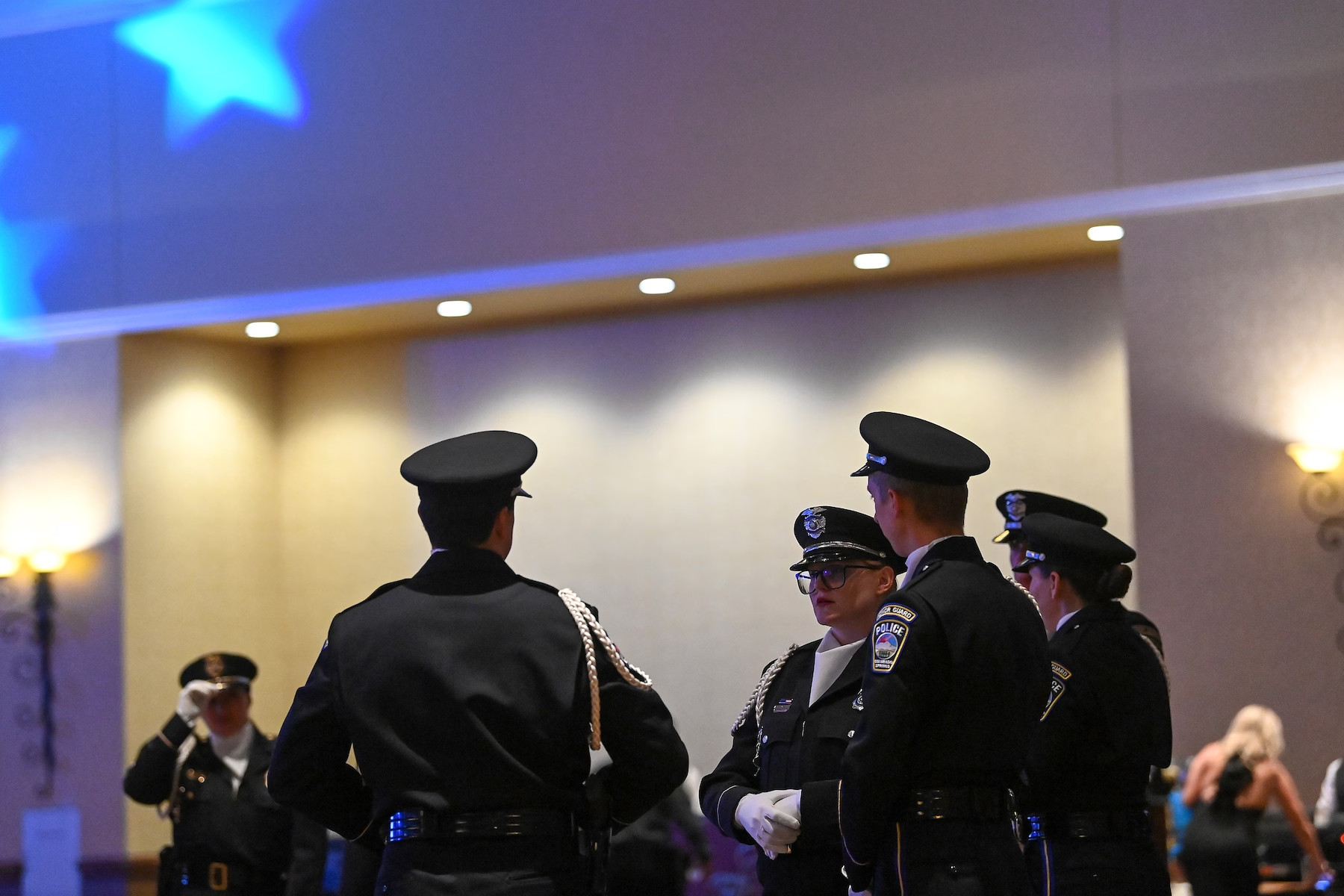
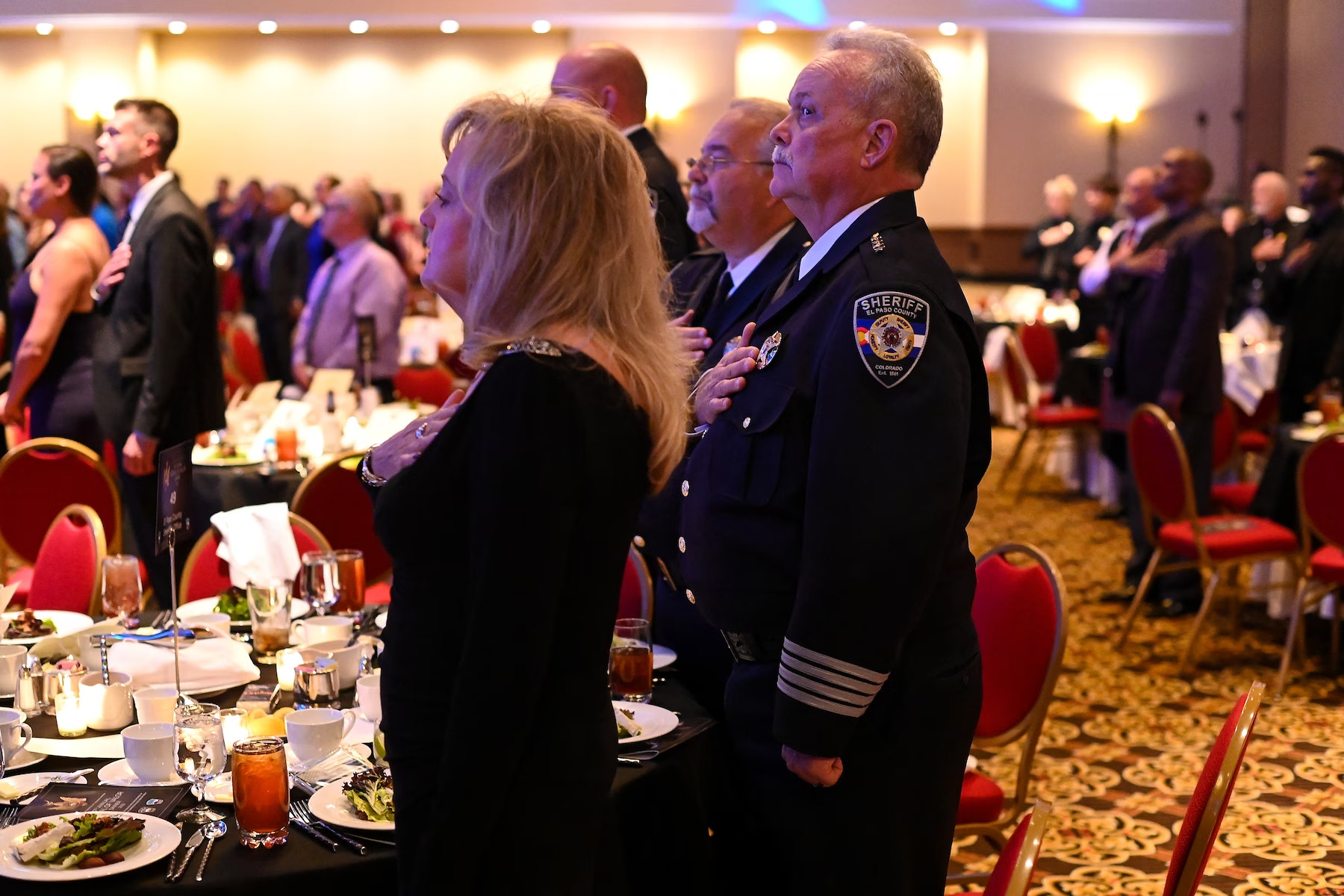
Officers, left, and El Paso County Sheriff Bill Elder, right, at the ceremony.
In neighboring El Paso County, Sheriff Bill Elder vowed that his department would not file any petitions under the new gun-seizure measure. And Elder kept his word until he left office in January, according to the sheriff’s office.
Elder declined to be interviewed for this article. But he said in 2019 that the law failed to address what he believes is the real problem behind American gun violence — mental health. The statute named for the slain deputy, Elder told the Colorado Springs Gazette at the time, focused “on the tool instead of the crisis that brings the thing before the judge.”
Burns said progressive initiatives in the legislature, including measures taken to increase use of personal recognizance bonds, and local law enforcement’s hesitance to make use of some gun-control measures are being felt on the street.
“We’ve always been at full saturation with guns,” Burns said. “Quite tragically, now we’re seeing a lot of lawlessness around that.”
More than 7,000 firearms have been stolen since 2017 in Colorado Springs alone, according to police department data, more than four times the rate of firearm thefts nationally, according to Justice Department statistics. One of those stolen guns, a pistol, was used to shoot a Colorado Springs officer in the head in 2018 — he survived.
The specter of his own death, or that of another officer, loomed for Burns as he confronted Quintana at the gas station nearly two years ago. Quintana reached for the door of the parked car, making Burns’s decision easier.
Burns squeezed the trigger of his AR-15 twice.
The first 5.56 round wedged into a street curb 40 yards past Quintana. The second entered his belly, center mass.
As paramedics arrived, a fellow officer kicked aside Quintana’s gun. Quintana died at a nearby hospital.
None of the officers had a second thought about the weapon until five days later, when investigators revealed it was not a rifle, as it appeared, but a realistic-looking toy gun designed to fire nonlethal plastic pellets.
The discovery stunned Burns. “It’s a conundrum,” he said. “The idea that you would make a kids’ toy to look indistinguishable from a real gun is crazy.”
‘Too much responsibility’
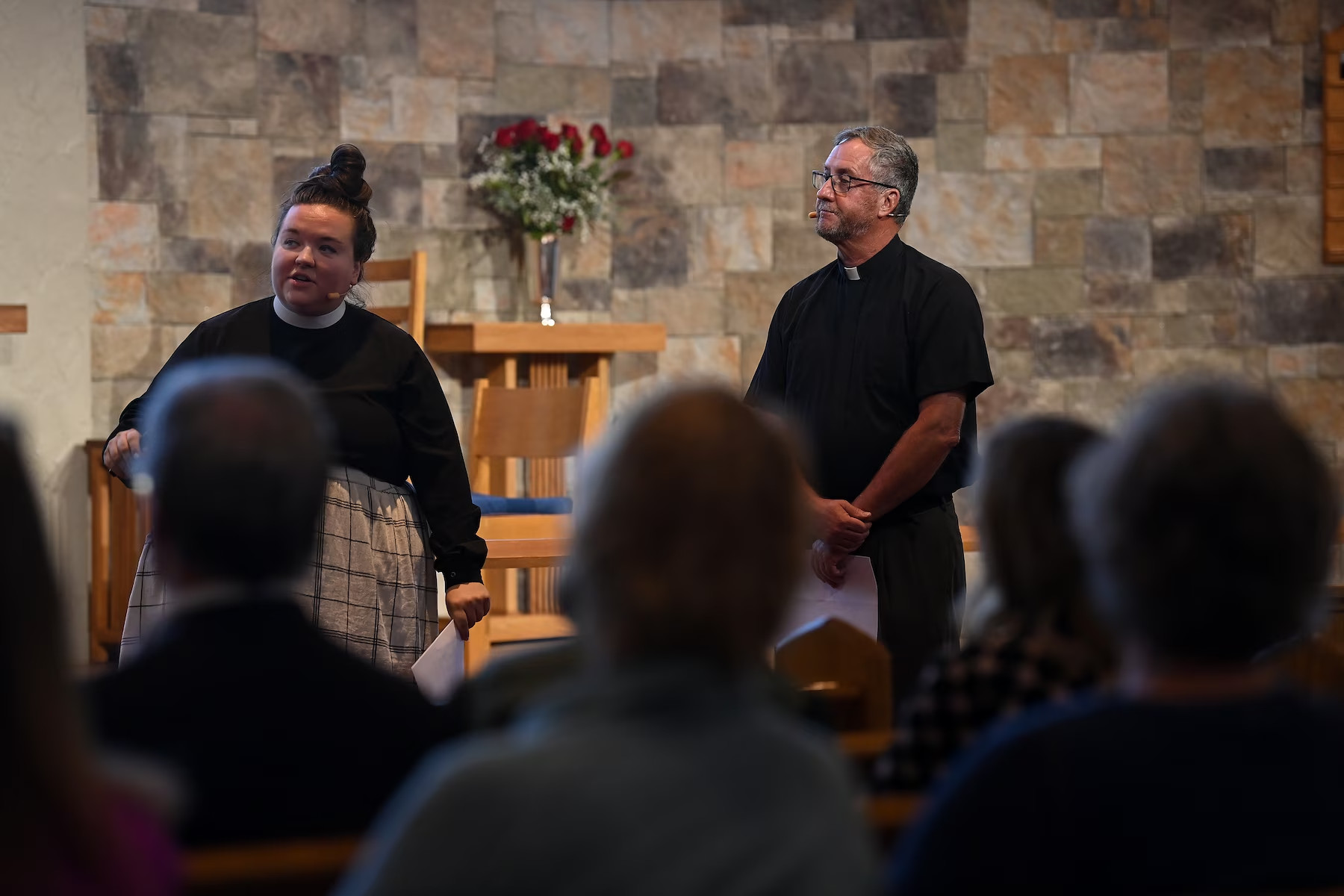
Darress with the Rev. Angela Lerena at St. Michael's Episcopal Church in Colorado Springs. After retiring from policing, he became a deacon.
Darress retired in 2020, five years after the mass shooting that ended outside the Wendy’s in downtown Colorado Springs, and 34 years after becoming a police officer.
He began a new career as an Episcopalian deacon ministering to the homeless and marginalized, following the example of his inspiration, St. Francis of Assisi, who is said to have kissed a leper and realized he had kissed the flesh of Jesus Christ.
Even now, he owns three guns, all pistols. He only keeps them for home protection and doesn’t shoot them, or even carry them outside his house.
“It’s too much responsibility,” he said.
Burns retired in August, after 24 years.
He’d always prided himself on not becoming the officer who withdrew emotionally and policed aggressively. Then a man with a facsimile rifle at a gas station interrupted that peace.
Burns spent two weeks after killing Quintana twisting with his decision to shoot, waiting to find out if he’d be indicted. Lying awake in the early-morning hours, he replayed the standoff in his head, reminding himself that Quintana never pointed his gun at anyone.
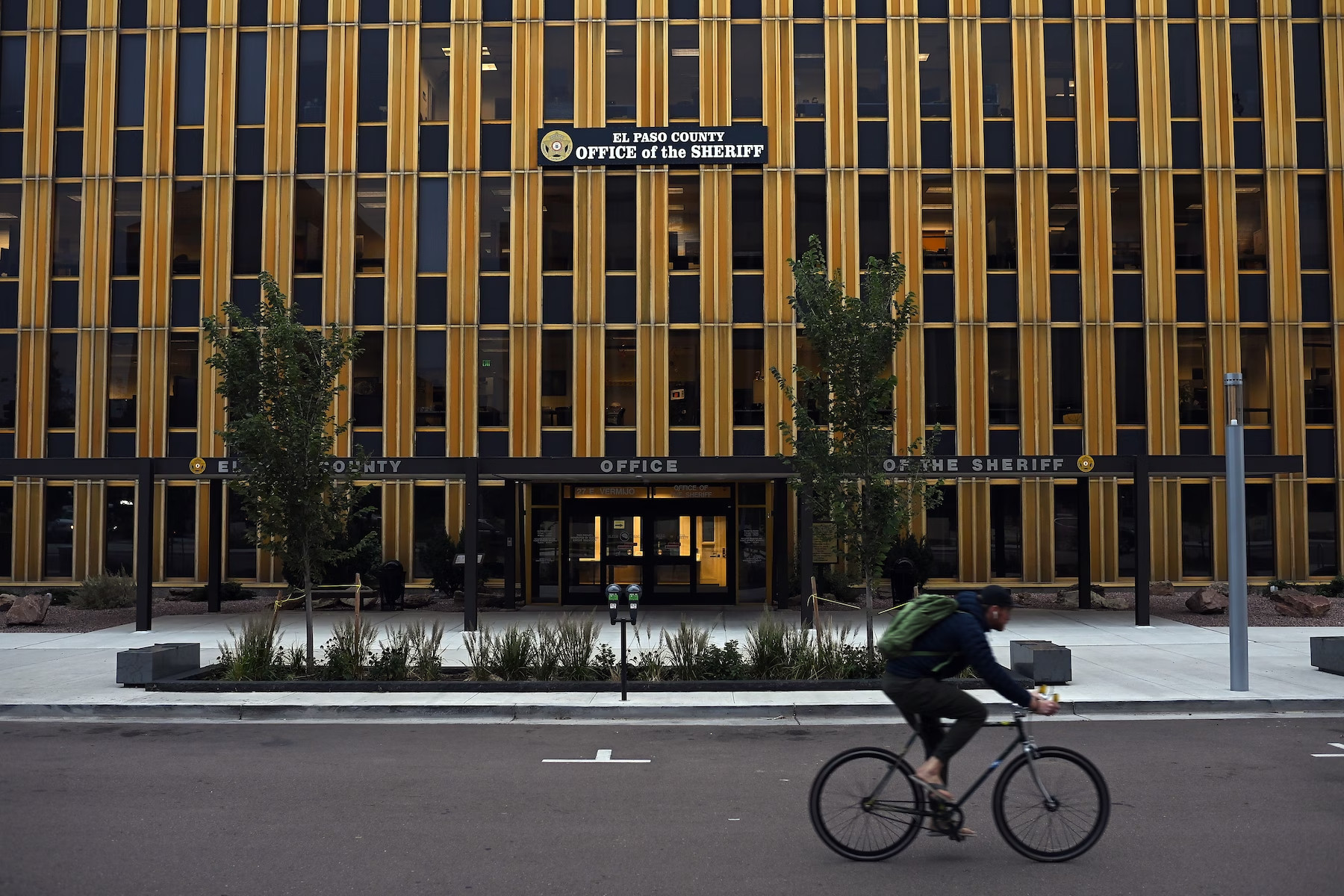
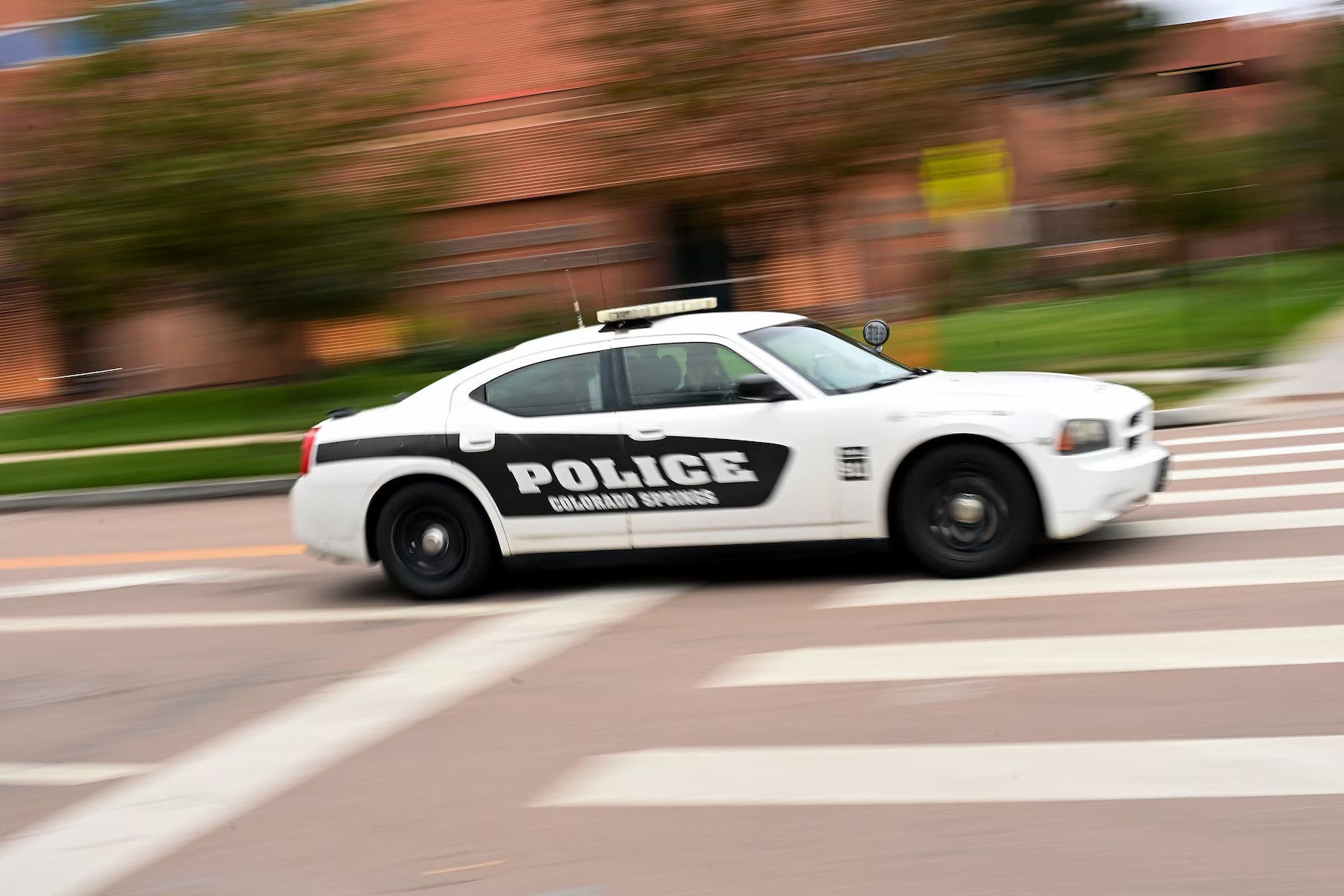
El Paso County's former sheriff vowed that his department would not file any petitions
under a gun-seizure measure passed in 2019. The Colorado Springs Police Department
issued Burns his first AR-15 in the mid-2000s.
The day Burns returned to duty he was rolling alone, left without a beat partner because of staff vacancies. He pulled up to the same cluster of businesses where he had encountered Quintana — an area where officers on patrol often discover stolen vehicles — picked up his binoculars and began running license plate numbers. Sure enough, the first plate he plugged into the computer belonged to a car that had been reported stolen.
He drove over and asked a woman to get out of the vehicle. Instead, she reached behind her seat.
“I was already at a 9 out of 10 stress level, being back there, and then when she did that I jumped to a 15,” Burns said.
Palms sweating, heart racing, Burns watched in slow motion as the woman’s hand returned empty. She eventually exited the vehicle and complied with commands.
“She was just being stupid,” Burns said.
The district attorney cleared him of any wrongdoing in the Quintana shooting, saying Burns had a “reasonable belief” Quintana posed an “imminent danger” to the public. Fourteen months later he turned in his department-issued pistol and brought his AR-15 home for the last time. He still trains with it, but it stays locked up in his house when not at the range.
Some Fridays, he has lunch at a local restaurant with Darress and a rotating cast of long-toothed cops.
In September, Burns was honored at a Medal of Valor ceremony for the Colorado Springs Police Department. Wearing a black suit, he stood alongside a parade of honorees in dress blue uniforms who accepted awards for their handling of critical incidents in 2021.
The banquet featured body-camera footage for each of the award-winning interactions and interviews with officers. Burns’s reel never mentioned that Quintana’s gun was a fake.
Burns says he attends a left-leaning church, by Colorado Springs standards, where only a few members carry weapons in church. There’s positive sentiment among the flock for a national assault weapons ban, he said. With a hitch:
“They don’t want to give up their own. They say, ‘Oh, no. I’m okay. I know what I’m doing.’”
About this story
- Reporting by Robert Klemko.
- Photography by Joshua Lott.
- Design and development by Aadit Tambe and Anna Lefkowitz. Design editing by Madison Walls. Photo editing by Natalia Jimenez.
- Editing by Debbi Wilgoren, Peter Wallsten and Wendy Galietta. Additional editing by Jordan Melendrez, Kim Chapman and Tom Justice.
- Additional support from Sarah Murray, Courtney Beesch, Angel Mendoza, Kyley Schultz, Brandon Carter. Ashleigh Wilson, Jai-Leen James and Bryan Flaherty.
- Robert Klemko covers criminal justice in America, from policing to the broader justice system and the ongoing campaign for reform. Twitter
- Joshua Lott is a staff photojournalist for The Washington Post and a part of the Race and Identity team. Before joining The Post, he was a regular contributor to: The New York Times, Reuters, Getty Images, The Guardian, The Wall Street Journal and Agence France-Presse. His work has been featured in publications around the world. Twitter
| . |
| HOME | BRIEFS | L020-IS-ISSUES-ALPHA | L020-IS-ISSUES-CHRONO | Last txt00024409 | Next txt00024411 |